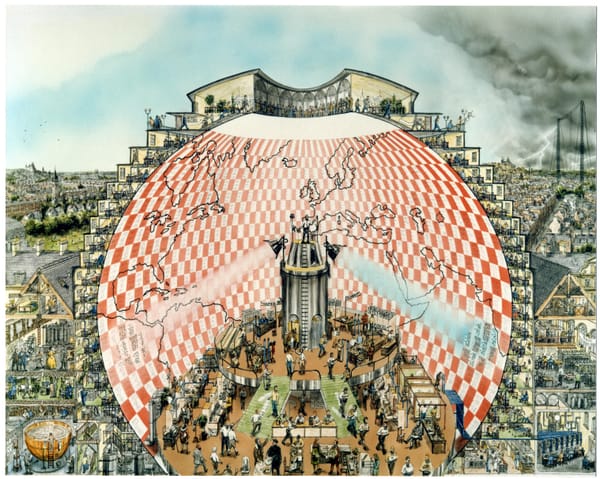Pathways

Last month I was invited to give a lecture on earth science to a group of 8th graders at a nearby middle school. I leaped at the chance. Although my day job is teaching university students, it’s not often I get to share science stories with kids at that awkward and magical threshold between childhood and adulthood. “Don’t be put off by their body language,” their teacher advised me. “They might look bored and slouching, but they’ll be paying attention.” The 150 or so kids filed into the auditorium, clumped together in friend groups, chattering away like magpies.
In a 20-minute whirlwind, I shared some of my favorite discoveries about earth’s distant past, concluding with a look at ice cores and the Keeling Curve. Then the hands shot up. How do scientists get gas samples out of the ice cores? If geologists can reconstruct past continents, can they project future continents too? How does the moon influence the earth? How has the unfolding of climate change affected the way earth scientists work?
After the class was dismissed, a knot of kids stayed on to ask yet more questions. A few even trailed me to the school doors. It is sometimes said that this generation’s attention span has been stunted by smart phones, but if so, I saw no sign of it in their eager curiosity.
As I left the school, it dawned on me that these kids will be in their late 80s in the year 2100. That particular year holds a special place in the annals of earth science. Since the very first report by the Intergovernmental Panel on Climate Change (IPCC) in the early 1990s, the year 2100 has been the target date for long-term projections of climate change. When today’s middle schoolers are octogenarians, they will learn the answer to the riddle of our times: what will planet earth look like in the year 2100?
In their most recent report, IPCC looked at five scenarios for the remainder of the century. Known as Shared Socioeconomic Pathways (SSPs), these scenarios describe alternative visions of the future that today’s middle schoolers might end up witnessing. Two scenarios in particular stand out as plausible endpoints on a spectrum of possibility: the Rocky Road, and the Green Road.
The Rocky Road scenario (known technically as SSP3-7.0, or “Regional Rivalry”) represents a world in which “a resurgent nationalism, concerns about competitiveness and security, and regional conflicts push countries to increasingly focus on domestic or, at most, regional issues. … Economic development is slow, consumption is material-intensive, and inequalities persist or worsen over time” (O’Neill et al., 2017). In this grim vision, by the year 2100 our now-octogenarian kids are sharing the planet with over twelve billion others. They are doing their best to survive in a world that averages 6 to 7 oF hotter (+3.6 oC) than it was in pre-industrial times. Carbon dioxide in the atmosphere has doubled since the 2020s, to a level last seen on earth millions of years ago—long before the existence of anything resembling Homo sapiens. The seas are nearly three feet higher and still rising; coastlines are littered with the wave-bashed remains of former cities and towns. The now-elderly middle schoolers look back to a time when diseases like dengue fever and malaria were virtually unheard of in North America, when food and other goods were affordable and abundant, when droughts, floods, and fires were not nearly so common. They look back to a time before killer heat waves, which have now become routine tragedies in the warmer parts of the world.
Fortunately, this grim path is not set in stone. A more cheerful alternative is SSP1-2.6: The Green Road. In this scenario, “the world shifts gradually, but extensively, toward a more sustainable path, emphasizing more inclusive development that respects predicted environmental boundaries” (O’Neill et al., 2017). By 2100, the kids who came of age back in the 2020s now share the planet with a stable population of about 7 billion, a bit less than today. Human prosperity is now powered by what the writer Bill McKibben calls “energy from heaven, not energy from hell”. Around the year 2070, the world reached a major milestone: net zero carbon emissions. The climate system responded. Earth of the year 2100 averages about three oF warmer (1.8 oC) than it was in the days of Abraham Lincoln: a bit hotter than the 2020s, but a far cry from the nightmare of the Rocky Road. Sea level has risen by a couple of feet. Glaciers are still melting, and the wild weather of the early 21st century persists. But overall the news is good: smart policy choices, propelled by a combination of activism and an increasingly competitive market for renewable energy, have steered the planet away from catastrophe. The climate is on course back toward the cooler, calmer world that prevailed through most of recorded history. The now-elderly middle schoolers look back with pride on what their generation has achieved.
There’s plenty of debate about the plausibility and likelihood of these and other scenarios (e.g., Hausfather & Peters, 2020). Some would no doubt argue, for example, that the entrance to the Green Road is already receding. On the other hand, even as greenhouse gas emissions continue to rise, the costs of renewable energy have plunged faster than even the most optimistic analysts predicted (Creutzig et al., 2017; McKibben, 2025). The future is not yet written, and it remains ours to write.
What kind of planet will today’s middle school kids inherit? What pathways will the world follow? Much depends on policy choices now and in the near future. Those in turn depend on the public’s attitude toward scientific understanding. On that score, recent trends in the United States don’t offer much encouragement. But those trends don’t jibe with what I saw on my visit to the school that day. To the contrary, the lively curiosity and imagination of the kids I met last month gives me hope that the next generation is already rising to the challenge.
References and further reading
Creutzig, F., Agoston, P., Goldschmidt, J. C., Luderer, G., Nemet, G., & Pietzcker, R. C. (2017). The underestimated potential of solar energy to mitigate climate change. Nature Energy, 2(9), 1-9.
Hausfather, Z., & Peters, G. P. (2020). Emissions–the ‘business as usual’ story is misleading. Nature, 577(7792), 618-620.
Masson-Delmotte, V., Zhai, P., Pirani, A., Connors, S. L., Péan, C., Berger, S., ... & Zhou, B. (2021). Climate change 2021: the physical science basis. Contribution of working group I to the sixth assessment report of the intergovernmental panel on climate change, 2(1), 2391.
McKibben, B. (2025) Here Comes the Sun: A Last Chance for the Climate and a Fresh Chance for Civilization. Norton.
Meinshausen, M., Nicholls, Z. R., Lewis, J., Gidden, M. J., Vogel, E., Freund, M., ... & Wang, R. H. (2020). The shared socio-economic pathway (SSP) greenhouse gas concentrations and their extensions to 2500. Geoscientific Model Development, 13(8), 3571-3605.
O’Neill, B. C., Kriegler, E., Ebi, K. L., Kemp-Benedict, E., Riahi, K., Rothman, D. S., ... & Solecki, W. (2017). The roads ahead: Narratives for shared socioeconomic pathways describing world futures in the 21st century. Global environmental change, 42, 169-180.
Robinson, K.S. (2020) The Ministry for the Future. Orbit Books.




